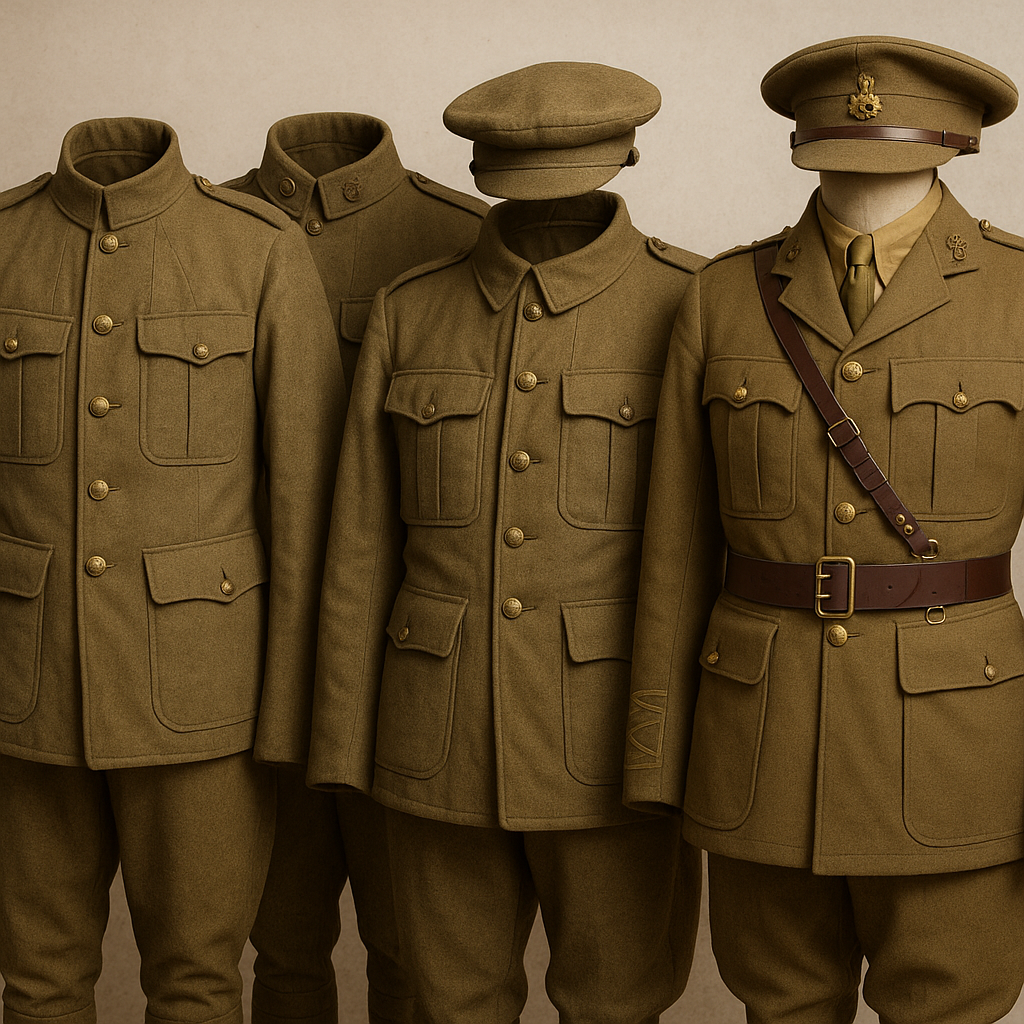
WW1 Jackets & Officer Uniforms: A Complete Guide to World War I Army Uniforms"
Published on Jul 10, 2025
WW1 Jackets & Officer Uniforms: A Complete Guide to World War I Army Uniforms
World War I was more than just a pivotal point in military history — it also marked a turning point in how soldiers dressed, fought, and survived. The World War I army uniform was not merely a symbol of military pride; it was a piece of functional design tailored for the challenges of early 20th-century warfare.
Today, WW1 jackets and officer uniforms remain cherished pieces of history, collected by enthusiasts, worn by reenactors, and studied by historians around the world. If you’ve ever been curious about the evolution of these garments or wanted to purchase a historically accurate replica, this guide is for you.
The Importance of Uniforms in WW1
During World War I (1914–1918), millions of men were drafted into armies across Europe, North America, and beyond. Uniforms served as a critical part of the military structure — not only for practicality and protection but also for identification and morale.
Unlike previous wars, WW1 brought new environmental challenges, including trench warfare, gas attacks, and prolonged exposure to cold, mud, and wet conditions. As a result, military clothing evolved rapidly, with governments investing in materials and designs that could withstand the brutal conditions of modern warfare.
Key Elements of WW1 Jackets
The WW1 jacket, often referred to as the "service coat" or "tunic," was a central part of the soldier’s wardrobe. It was designed to be durable, functional, and suited to various climates and terrains.
Key Features:
- Wool Fabric: Most WW1 jackets were made from tightly woven wool, which offered insulation and limited water resistance.
- High Collars: Early war tunics featured stand-up collars, later replaced by more relaxed designs to improve comfort.
- Epaulettes and Insignia: Shoulder straps were used to display rank insignia, unit badges, and other identifiers.
- Button Fronts: Jackets often featured brass or metal buttons with regimental markings.
- Pockets: Four large pockets (two on the chest and two lower) provided essential storage for rations, maps, or small tools.
At Paddelaters, we take pride in offering replicas that capture these details with incredible accuracy, from stitching patterns to authentic military-grade wool.
WW1 Officer Uniforms: Distinction Through Detail
Unlike standard infantrymen, officers in World War I had uniforms that reflected their leadership position and class status. The WW1 officer uniform was often custom-tailored, resulting in better materials, fit, and stylistic flourishes.
Key Differences in Officer Uniforms:
- Higher-Quality Fabric: Officers often wore finer wool and occasionally added silk or cotton linings.
- Sam Browne Belt: This leather belt crossed over the shoulder and around the waist, becoming a signature of officer attire.
- Tailored Fit: Officer tunics were more form-fitting and often featured longer skirts and sharper cuts.
- Pip Insignia: Rank was indicated with “pips” (stars) on shoulder straps or cuffs, with brass or silver detail work.
- Service Dress Cap: Officers typically wore peaked caps rather than the soft trench caps or helmets of enlisted men.
Owning or wearing a WW1 officer uniform offers a glimpse into the structured world of early 20th-century military command. Whether you’re portraying a British lieutenant or a German field officer, getting the details right matters — and our curated collection ensures you’ll find a faithful reproduction.
Comparing Major WW1 Army Uniforms
Let’s take a look at how the uniforms differed between key nations during the Great War:
NationNotable Features of Uniforms
British Khaki wool tunics, 1902 Pattern service dress, puttees, and Brodie helmets
German Field-gray tunics, Pickelhaube spiked helmets (early war), later replaced with Stahlhelm.
French Initially bright blue and red, changed to “horizon blue” wool for camouflage.
American Olive drab wool uniforms modeled after British and French styles, M1917 helmets
The World War I army uniforms were not just tools of war — they were expressions of national identity, innovation, and adaptation under extreme conditions.
WW1 Uniform Accessories
To complete the authentic look of a World War I soldier, accessories were just as important as the uniform itself.
Common accessories included:
- Puttees: Long strips of cloth wound around the lower leg for protection and warmth.
- Steel Helmets: Offered improved protection against shrapnel. Designs varied between nations.
- Gas Masks: Essential for survival in chemical warfare, usually carried in canvas haversacks.
- Greatcoats: Heavy overcoats used in colder climates or during trench stints.
- Trench Knives and Equipment Belts: Functional gear for close combat and tool storage.
Why Choose Authentic Replicas from Paddelaters?
At Paddelaters.com, we specialize in high-quality, historically accurate WW1 uniforms and accessories. Every stitch, fabric choice, and button is made with attention to historical detail — perfect for:
- Historical Reenactments
- Film & Theatre Production
- Collectors & Historians
- Museum Displays
What sets us apart?
- Premium Wool & Authentic Materials
- Custom Sizing Available
- Worldwide Shipping
- Historically Accurate Patterns
Whether you're searching for a WW1 jacket to complete your collection or a full WW1 officer uniform for an upcoming reenactment, Paddelaters delivers craftsmanship and authenticity.
Final Thoughts: A Legacy Worn with Pride
From the trenches of Verdun to the battlefields of the Somme, World War I army uniforms represent a time when courage, duty, and innovation met under fire. Wearing a faithful replica of a WW1 jacket or officer uniform isn’t just about style — it’s about honoring history.
